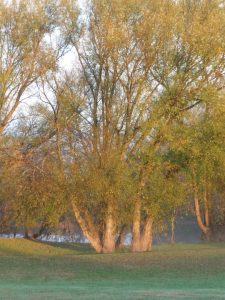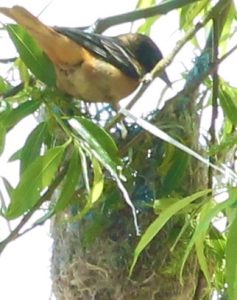Authored by: Carolyn Aita
 Dodge County is graced with many lakes, rivers, and streams. Much of the shoreline of this vast water network is on private land, and we manage it for recreational use, property beautification, and for the creatures who inhabit this place between land and water, known as the riparian zone. A tall, broadleaved, deciduous tree, one that sheds its leaves each year, makes an ideal “specimen” in a riparian garden. It provides shade in summer and adds visual structure to a frozen winter landscape. Underground, its roots form complex structures that slow bank erosion. Above ground, branches and leaves slow falling rain so that water can soak into the earth and return to the aquifer. A riparian tree must tolerate yearly spring flooding as well as off-season temporary flooding. In our climate, there are at least eight groups, botanical genera, from which to choose a riparian tree: maple, alder, birch, ash, oak, poplar, and willow. Let’s consider some choices.
Dodge County is graced with many lakes, rivers, and streams. Much of the shoreline of this vast water network is on private land, and we manage it for recreational use, property beautification, and for the creatures who inhabit this place between land and water, known as the riparian zone. A tall, broadleaved, deciduous tree, one that sheds its leaves each year, makes an ideal “specimen” in a riparian garden. It provides shade in summer and adds visual structure to a frozen winter landscape. Underground, its roots form complex structures that slow bank erosion. Above ground, branches and leaves slow falling rain so that water can soak into the earth and return to the aquifer. A riparian tree must tolerate yearly spring flooding as well as off-season temporary flooding. In our climate, there are at least eight groups, botanical genera, from which to choose a riparian tree: maple, alder, birch, ash, oak, poplar, and willow. Let’s consider some choices.
Red maple (Acer rubrum) is the flaming red-leaved tree that takes our breath away as we ride along country roads in autumn. It grows rapidly, up to 5 feet/year, with a neat upright rounded form that can reach 70 feet at maturity. In “tree-time” red maple has a short maximum life expectancy, only 100 years. But we live in human-time, and a newly planted red maple will be enjoyed for much if not all of one’s life. Silver maple (Acer saccharinum), taller, rangier, and longer-lived than its red cousin, lights up the autumn landscape with bright yellow leaves. It is beloved by wildlife for food and shelter. Its showy yellow blossoms provide critical early spring nectar for wild bees.
Two riparian trees that can be uplimbed to form a high canopy are swamp white oak (Querus bicolor) and eastern cottonwood (Populus deltoides). Swamp white oak grows rapidly to 100 feet at maturity and has a life expectancy of 350 years. Characteristic of the oak genus, swamp white oak is marcescent; its leaves wither in autumn but tend not to fall until spring. Eastern cottonwood with a mature height of 190 feet is a truly towering tree. This Godzilla grows rapidly but its life expectancy is merely 100 years.
 River birch (Betula nigra) offers multi-stemmed beauty. Its ornamental peeling bark is characteristic of the birch genus. It is widely used for landscaping as well as for riparian buffering. River birch grows rapidly to a mature height of 70 feet. As a bonus, its sap can be fermented to make birch beer. Another fast-growing multi-stemmed tree, black willow (Salix nigra), is already ubiquitous along our shorelines, a testament to its conservation value as a shoreline soil-binder. Red-spotted purple and viceroy butterflies lay their eggs on black willow leaves. Insectivorous birds nest in black willow and feed on the large selection of insects that make this tree their home. But the less attractive aspects of black willow should be considered before choosing it as a landscape tree: it relentlessly suckers, loves nearby sewer lines, and its weak wood results in broken branches and twigs.
River birch (Betula nigra) offers multi-stemmed beauty. Its ornamental peeling bark is characteristic of the birch genus. It is widely used for landscaping as well as for riparian buffering. River birch grows rapidly to a mature height of 70 feet. As a bonus, its sap can be fermented to make birch beer. Another fast-growing multi-stemmed tree, black willow (Salix nigra), is already ubiquitous along our shorelines, a testament to its conservation value as a shoreline soil-binder. Red-spotted purple and viceroy butterflies lay their eggs on black willow leaves. Insectivorous birds nest in black willow and feed on the large selection of insects that make this tree their home. But the less attractive aspects of black willow should be considered before choosing it as a landscape tree: it relentlessly suckers, loves nearby sewer lines, and its weak wood results in broken branches and twigs.
These are only a few of our choices for tall shoreline trees. Each selection brings with it a unique environment and the opportunity to start a new understory garden.
Carolyn Aita
Master Gardener Volunteer




